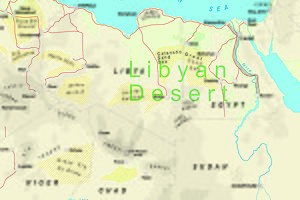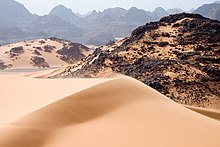Libyan Desert


The Libyan Desert (not to be confused with the Libyan Sahara) is a geographical region filling the northeastern
. This obscurity saw the region overlooked by early European explorers, and it was not until the early 20th century and the advent of the motor car before the Libyan Desert started to be fully explored.Nomenclature
The term Libyan Desert began to appear widely on European maps in the last decades of the 19th century, typically identified as straddling the borders of present-day Egypt and Libya. This name derived from a territory known as
Geography
The Libyan Desert covers an area of approximately 1,300,000 km2 (500,000 square miles), and extends approximately 1,100 km (680 miles) from east to west, and 1,000 km from north to south, in about the shape of a rectangle slanting to the south-east. Like most of the Sahara, this desert is primarily sand and hamada or stony plain.
Sand plains,
The desert features a striking diversity of landscapes including mountains, oases, and sand seas.

To the south lie the main mountain ranges, from the
Other features are the
The Libyan Desert is barely populated apart from the modern settlements at
Climate
The Libyan desert is said to be one of the least hospitable regions on Earth. Its climate is surprisingly variable, being hot in summer, with average daytime temperatures of 50 °C (122 °F) and above, though this drops rapidly at night. In winter, days are cool, with temperatures averaging 27 °C (81 °F), but at night this can drop below freezing, with temperatures of −9 °C (16 °F) recorded. At these times the formation of
In the north, along the Mediterranean shore, cool onshore winds blow inland, while further south, hot, dry winds, known as
History
Historical desert
Historically, "Libya" referred to an ill-defined area to the west of
World War I
Following the conquest of the territory by Italy during the
Modern exploration
During the 1930s the Libyan desert was the scene of exploration and mapping by the Italian Army and Air Force. Others, such as Ralph Bagnold and László Almásy also travelled in south-eastern Libya and southern Egypt, searching for the lost oasis of Zerzura. Bagnold also travelled into northern Chad, to the Mourdi Depression, recording his findings in his book Libyan Sands: Travel in a Dead World, which was published in 1935.
World War II
During the
The Calanshio Sand Sea is the site of the missing World War II aircraft Lady Be Good. The wreck was discovered 200 km (120 mi) north of Kufra 15 years after it was reported missing in 1943.
See also
References
- ^ a b The Libyan Sahara at temehu.com
- ^ Marq de Villers & Hirtle 2003, p. 85.
- ^ "Libya - Climate | Britannica". www.britannica.com. Retrieved 31 October 2022.
- ^ Pitt 1980, p. 13.
- S2CID 161840012.
- ^ Pitt 1980, pp. 235–240.
Further reading
- Pitt, Barrie (1980). The Crucible of War: Western Desert 1941. Jonathan Cape. ISBN 0-224-01771-3.
- Marq de Villers; Hirtle, Sheila (2003). Sahara: The Life of the Great Desert. HarperCollins. ISBN 0-00-714820-8. Retrieved 18 February 2023.
- Goudie, Andrew (2002). Great Warm Deserts of the World, OUP. ISBN 0-199-24515-0.
- Bagnold, Ralph (2010). Libyan Sands: Travel in a Dead World, Eland. ISBN 1-906-01133-8.
- Monod, Theodore (1994). Désert libique, Arthaud. ISBN 2-7003-1023-3.
- Ahmed Hassanein Bey, (2006). The Lost Oases, AUCP. ISBN 1-59048-146-1.
- László Almásy (1934). Unknown Sahara (PDF). Retrieved 18 February 2023.
External links
- The Libyan Desert at fjexpeditions.com.
- Libyan Desert at African volunteer.net. Retrieved 6 November 2016.
- The complete text and photos of the discoveries of Ahmed Pasha Hassanein in the Libyan Desert, National Geographic Magazine, September 1924.
- Gilf Kebir, Uweinat and the Great Sand Sea.
